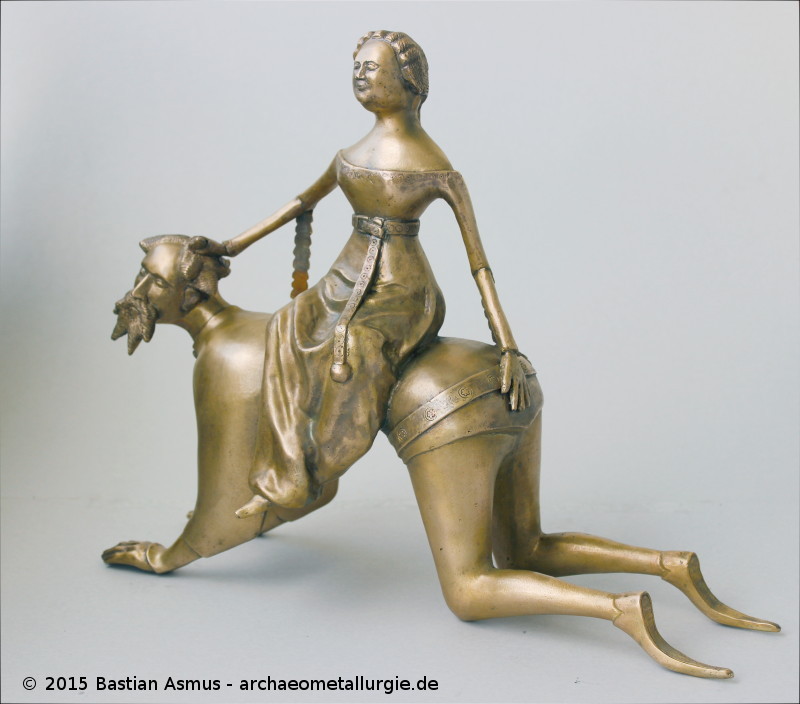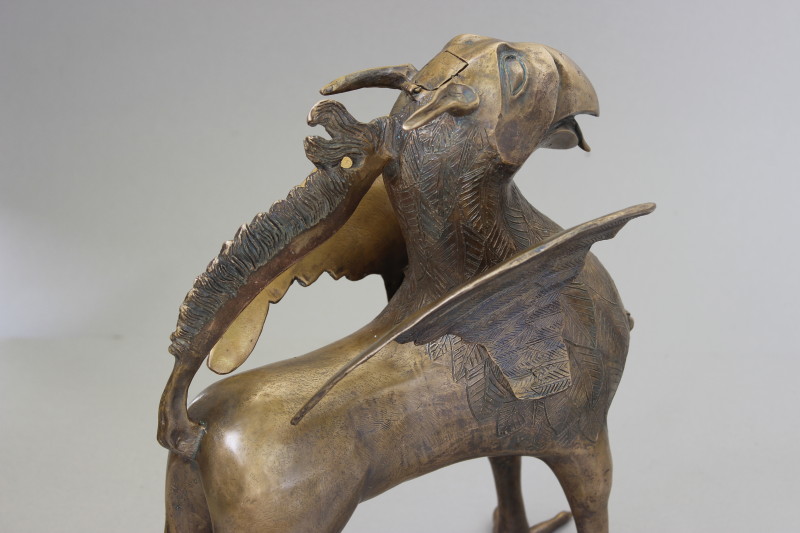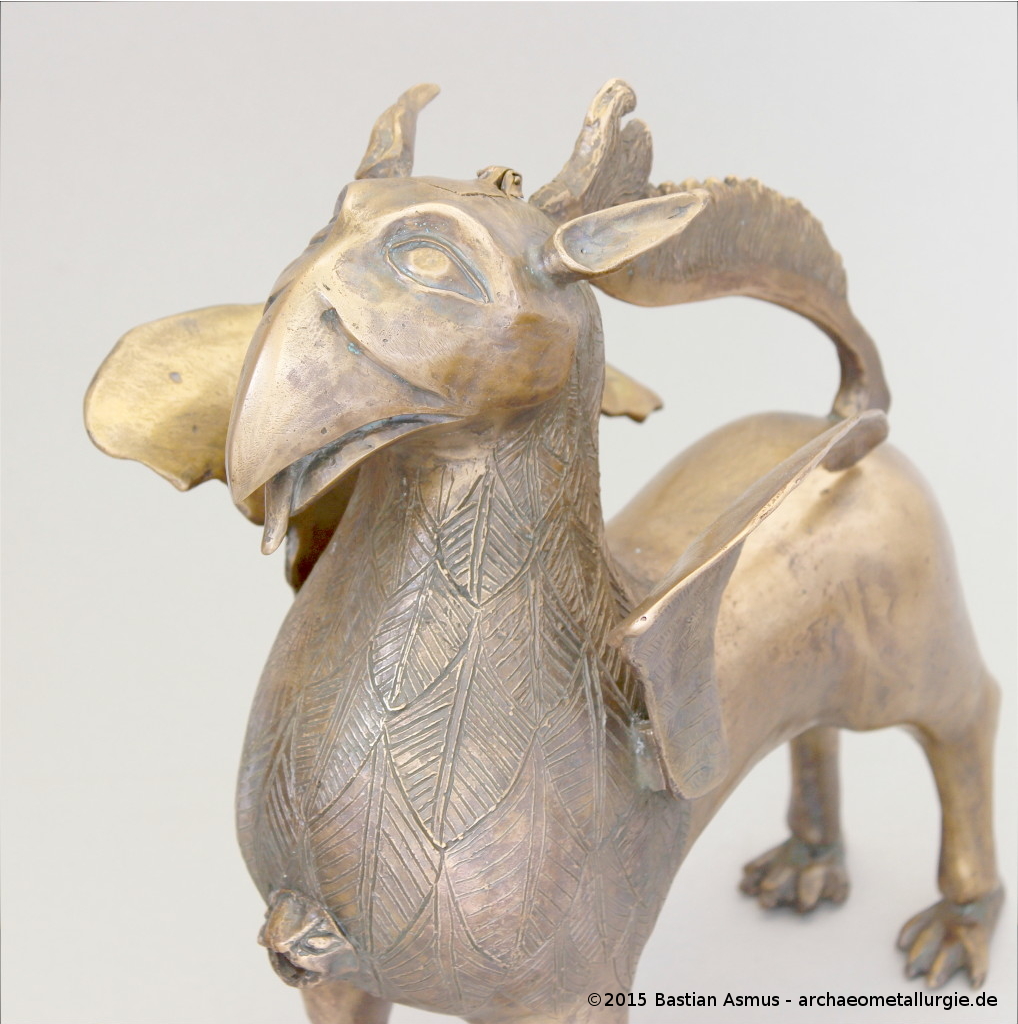Jun
8
2015
Bastian Asmus

Aristotle and Phyllis aquamanile, 2015 by Bastian Asmus made after a 15th century original from the low countries.
The Middle High German lay of Aristotle and Phyllis probably originated in the 13th century in the upper Rhine region between Basel and Strasbourg. The story was a popular motif and is found not only in sculptural works, but also in tapestries and drawings. King Philip of Macedonia’s son Alexander, later called the Great, is educated by Aristotle. The young Alexander, madly in love with the beautiful Phyllis, is scolded by his teacher for his mental absence and warned of the dangers of love and/or women. Aristotle effects the separation of the lovers through intervention with the King. Musing on revenge beautiful Phyllis seduced Aristotle. As price for her love she demanded that she could ride around in the gardens on his back. Whilst doing so Aristotle is discovered by the Queen and Aristotle falls prey to shame and disgrace, because he could not meet his own requirements. He was exiled and pondered over the wickedness of the world.

Aristotle and Phyllis. Hausbuchmeister 15th century. Source: Wikimedia Commons.
The Aristotle and Phyllis aquamanile was modelled in wax and cast in the lost wax technique. It can now be seen in the newly founded European Hanseatic league Museum.
no comments | tags: Aquamanile, aquamanilia, archaeology, archaeometallurgy, art, casting, practical archaeometallurgy, sculptor | posted in Aquamanile, Archaeometallurgy, Metal casting, practical metallurgy, Reconstructions
May
23
2015
Bastian Asmus

This aquamanile in the form of a knight on horseback was cast in 2015 in Bastian Asmus’ workshop, and leans heavily on an original from the 13th century. It was cast in bronze by the lost wax technique.
Next to lion and griffin aquamanile a knight on horseback was a widely used form of aquamaniles . One of these I made earlier this year and cast it in bronze in my workshop. The original aquamanile is from the 13th century from northern Germany, probably around Hildesheim.
This object displays the impressive skills of the 13th century artists and foundrymen. The arms, legs and stir-ups are modelled full round, which adds quite a bit of complexity to the preparation of the casting mould; especially when we are considering that these moulds were not made like modern investment moulds, but by applying moulding loam to every bit of wax surface. The materials thickness of the bridle or stir-ups is in places less than 2mm in diameter. The knight is not modelled separately but cast in one piece with the horse.
Just as the griffin aquamanile this reconstruction can be seen in the newly opened European Hanseatic League Museum in Lübeck, Germany.
Literature
{1698736:I8UJUA8R}
harvard1
default
asc
0
2726
no comments | tags: Aquamanile, aquamanilia, archaeometallurgy, art, casting, practical archaeometallurgy, Rotgießer, Rothschmied, sculptor | posted in Aquamanile, Archaeometallurgy, Info, Metal casting, practical metallurgy, Reconstructions
May
21
2015
Bastian Asmus

Aquamanile in the form of a griffin. The original is from a 15th century Nuremberg Rotschmied workshop. The pictured aquamanile was modelled by Ragna Asmus and cast by Bastian Asmus.
A griffin aquamanile made some 600 years later
I realise that I have been somewhat negligent over the past three to four months when it comes to writing. I was immersed in the most fascinating and satisfying work in the past four months, however and simply did not have time to write. Within the next few weeks I will post about the 12th to 15th century bronze and brass objects I was commissioned to reconstruct. Let us begin with my favorite piece today: The griffin aquamanile that is now housed in the Metropolitan Museum in New York.
This bronze aquamanile in the form of a griffin was cast in early 2015 and can be viewed from 30 May 2015, the newly established European Hanseatic League Museum. The Griffin was modelled by Ragna Asmus after a griffin aquamanile that was made in Nurmeberg between 1425 and 1450. It is significantly younger than the lion aquamanile I have made two years previously. In the 15th century Nuremberg was a leading centre of the brass and brass-ware production and had surpassed the importance Dinant held in the 12th and 13th centuries. From the 14th century the production of “Dinanderie” shifted from Dinant and the Meuse region to Nuremberg. After Dinant’s destruction in 1466 the metal trades in Nuremberg became an even more important one than Dinant ever was . The numerous professions in the Rotschmiedehandwerk may be seen as an evidence of this upsurge in productivity.
This aquamanile was completely remodelled in bee’s wax and cast in the lost wax process.

Aquamanile in the form of a griffin.
Literature
{1698736:W32WVGS7},{1698736:TIIAPF7E};{1698736:W32WVGS7},{1698736:TIIAPF7E}
harvard1
default
asc
0
2689
no comments | tags: Aquamanile, aquamanilia, casting, Nuremberg, practical archaeometallurgy, Renaissance, Rotgießer, Rothschmied | posted in Aquamanile, Archaeometallurgy, General, Metal casting, practical metallurgy, Reconstructions





